
Centipedes are predatory arthropods belonging to the class Chilopoda of the subphylum Myriapoda, an arthropod group which includes millipedes and other multi-legged animals. Centipedes are elongated segmented (metameric) creatures with one pair of legs per body segment. All centipedes are venomous and can inflict painful stings, injecting their venom through pincer-like appendages known as forcipules or toxicognaths, which are actually modified legs instead of fangs. Despite the name, no centipede has exactly 100 pairs of legs; number of legs ranges from 15 pairs to 191 pairs, always an odd number.
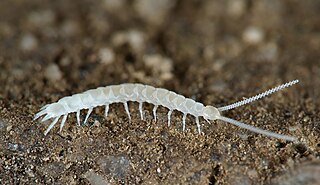
Symphylans, also known as garden centipedes or pseudocentipedes, are soil-dwelling arthropods of the class Symphyla in the subphylum Myriapoda. Symphylans resemble centipedes, but are very small, non-venomous, and only distantly related to both centipedes and millipedes. More than 200 species are known worldwide.

The Geophilomorpha, commonly known as soil centipedes, are epimorphic and bear upwards of 27 leg-bearing segments. They are eyeless and blind, and bear spiracles on all leg-bearing segments—in contrast to other groups, which usually bear them only on their 3rd, 5th, 8th, 10th, 12th, and 14th segments—a "mid-body break", accompanied by a change in tagmatic shape, occurring roughly at the interchange from odd to even segments. This group is the most diverse centipede order, with 230 genera. Centipedes in this order each have an odd number of leg-bearing segments ranging from 27 to 191. They also have 14–segmented antennae. This order is a monophyletic group including two suborders: the monophyletic Placodesmata, which contains Mecistocephalidae, and Adesmata, which includes the superfamilies Himantarioidea and Geophiloidea. Segment number is usually fixed by species in the family Mecistocephalidae, unlike the case in other families in this order, in which the segment number usually varies within each species. The name "Geophilomorpha" is from Ancient Greek roots meaning "formed to love the earth."

The Scolopendromorpha, also known as tropical centipedes and bark centipedes, are an order of centipedes whose members are epimorphic and usually possess 21 or 23 trunk segments with the same number of paired legs. The number of leg pairs is fixed at 21 for most species in this order and fixed at 23 for the remaining species, except for two species with intraspecific variation: Scolopendropsis bahiensis, which has 21 or 23 leg pairs, and Scolopendropsis duplicata, which has 39 or 43 leg pairs. Species in this order have antennae with 17 or more segments. The order comprises the five families Cryptopidae, Scolopendridae, Mimopidae, Scolopocryptopidae, and Plutoniumidae. Nearly all species in the family Scolopendridae have four ocelli on each side of the head, and the genus Mimops features a pale area often considered an ocellus on each side of the head, whereas the other three families are blind. Species in the family Scolopocryptopidae have 23 leg-bearing segments, whereas species in all other families in this order have only 21 leg-bearing segments. The only 3 known amphibious centipedes, Scolopendra cataracta, Scolopendra paradoxa and Scolopendra alcyona belong to this order.
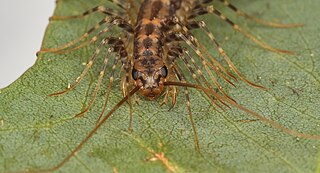
Scutigeromorpha is an order of centipedes also known as house centipedes. These centipedes are found in the temperate and tropical parts of every continent except Antarctica, with their distribution significantly expanded by the introduction of the Mediterranean species Scutigera coleoptrata throughout Europe, Asia, and North America. The common species S. coleoptrata is a typical representative of this order, lying in wait for other arthropods, then seizing prey using great speed, and all species in this order reflect adaptations for this mode of life.

The Lithobiomorpha, also known as stone centipedes, are an order of anamorphic centipedes; they reach a mature segment count of 15 trunk segments. This group has lost the compound eyes, and sometimes has no eyes altogether. Instead, its eyes have a single ocellus or a group of ocelli. Its spiracles are paired and can be found laterally. Every leg-bearing segment of this organism has a separate tergite, these alternating in length apart from a pair of long tergites on each of segments 7 and 8. It also has relatively short antennae and legs compared to the Scutigeromorpha. Two families are included, the Henicopidae and Lithobiidae. Although they have previously been regarded as wholly carnivorous, feeding primarily on insects but also occasionally slugs and worms, they have been proven to feed on leaf litter, as well as associated small animals.

Scolopocryptopidae is a family of blind centipedes in the order Scolopendromorpha. This family includes more than 90 species. Centipedes in this family are found mainly in the Americas and East Asia but have also been recorded in West Africa, New Guinea, and Fiji.

The Geophilidae are a polyphyletic, cosmopolitan family of soil centipedes in the superfamily Geophiloidea containing the mostly defunct clades Aphilodontidae, Dignathodontidae, Linotaeniidae, Chilenophilinae, and Macronicophilidae. These centipedes are found almost worldwide.

Himantariidae is a monophyletic family of centipedes in the order Geophilomorpha and superfamily Himantarioidea, found almost exclusively in the Northern Hemisphere. Centipedes in this family feature a short head with a concave labral margin bearing a row of denticles, a single dentate lamella and some pectinate lamellae on each mandible, second maxillae with strongly tapering telopodites and slightly spatulate claws, and a stout forcipular segment with short forcipules and a wide tergite; the ultimate legs usually have no pretarsus, and the female gonopods are distinct and biarticulate.
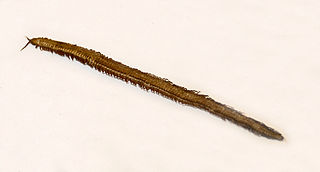
Oryidae is a monophyletic family of soil centipedes belonging to the superfamily Himantarioidea.
Dendrothereua is a genus of house centipedes in the family Scutigeridae. There are at least three described species in Dendrothereua, found in the southern United States and the Neotropics.
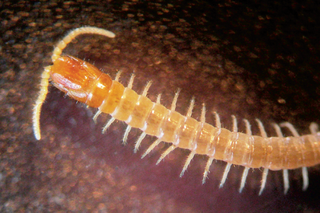
Mecistocephalidae is a monophyletic family of centipedes in the order Geophilomorpha. It is the only family in the suborder Placodesmata. Most species in this family live in tropical or subtropical regions, but some occur in temperate regions. This family is the third most diverse in the order Geophiliomorpha, with about 170 species, including about 130 species in the genus Mecistocephalus.
Linotaeniidae are a monophyletic clade of soil centipedes in the family Geophilidae found mostly in the temperate regions of the Holarctic as well as the south Andes. Species in the clade Linotaeniidae are characterized by a body that usually tapers toward the anterior tip; mandibles with a single pectinate lamella; second maxillae with coxo-sternite usually undivided and claws without projections; forcipular segment short, with tergite remarkably wide, forcipules evidently tapering; coxal organs opening through distinct pores on the ventral surface of the coxo-pleura. The number of legs in this clade varies within as well as among species and ranges from as few as 31 pairs of legs to as many as 83 leg pairs. Compared to most families in the suborder Adesmata, this clade features a modest number of leg-bearing segments and limited variation in this number within each species.

Schendylidae is a family of centipedes in the order Geophilomorpha found in the Americas, the Palearctic region, Africa, Madagascar, Australia, and southeast Asia, and also on some Pacific islands.
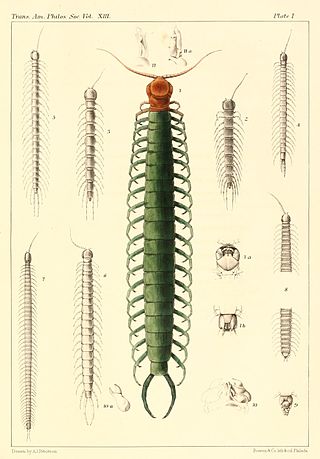
Scolopocryptops is a genus of bark centipedes in the family Scolopocryptopidae. There are over 20 described species in Scolopocryptops.

Ballophilidae is a monophyletic group of centipedes belonging to the order Geophilomorpha and superfamily Himantarioidea. Authorities now dismiss this group as a family, citing phylogenetic analysis, and instead refer to this clade as Ballophilinae, a possible subfamily within the family Schendylidae. Centipedes in this clade differ from others in the family Schendylidae by having bodies tapered toward the anterior tip, short heads, slender forcipules that are well apart, and an undivided lamina for the female gonopods. Centipedes in this clade are found in most tropical regions.
Gonibregmatidae are a paraphyletic family of soil centipedes belonging to the superfamily Geophiloidea.
Mecistocephalus is a genus of centipedes in the family Mecistocephalidae. It was described by British entomologist George Newport in 1843.
Gonibregmatus is a genus of centipedes in the family Gonibregmatidae. It was described by British entomologist George Newport in 1843.
Gonibregmatus plurimipes is a species of centipede in the Gonibregmatidae family. It was described in 1920 by American myriapodologist Ralph Vary Chamberlin.













